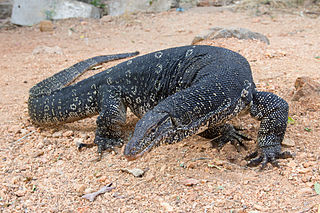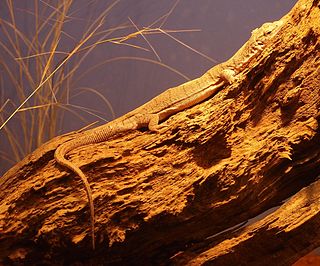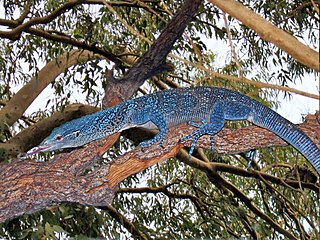
Monitor lizards are lizards in the genus Varanus, the only extant genus in the family Varanidae. They are native to Africa, Asia, and Oceania, and one species is also found in the Americas as an invasive species. About 80 species are recognized.

Megalania is an extinct species of giant monitor lizard, part of the megafaunal assemblage that inhabited Australia during the Pleistocene. It is the largest terrestrial lizard known to have existed, but the fragmentary nature of known remains make estimates highly uncertain. Recent studies suggest that most known specimens would have reached around 2–3 m (6.6–9.8 ft) in body length excluding the tail, while some individuals would have been significantly larger, reaching sizes around 4.5–7 m (15–23 ft) in length.

The Nile monitor is a large member of the monitor family (Varanidae) found throughout most of Sub-Saharan Africa, particularly in drier regions, and along the Nile River and its tributaries in East Africa. Additionally, there are modern, invasive populations in North America. The population found in West African forests and savannahs is sometimes recognized as a separate species, the West African Nile monitor. While it is dwarfed by its larger relatives, such as the Komodo dragon, the Asian water monitor or the crocodile monitor, it is still one of the largest lizards in the world, reaching Australia’s perentie in size. Other common names include the African small-grain lizard, as well as iguana and various forms derived from it, such as guana, water leguaan or river leguaan.

The Asian water monitor is a large varanid lizard native to South and Southeast Asia. It is widely considered to be the second-largest lizard species, after the Komodo dragon. It is distributed from eastern and northeastern India and Bangladesh, the Andaman and Nicobar Islands, Sri Lanka, through southern China and Hainan Island in the east to mainland Southeast Asia and the islands of Sumatra, Borneo, Java, Lombok, the Riau Archipelago, Sulawesi. It is one of the most widespread monitor lizards.

The crocodile monitor, also known as the Papuan monitor or Salvadori's monitor, is a species of monitor lizard endemic to New Guinea. It is the largest monitor lizard in New Guinea and is one of the longest lizards, verified at up to 255 cm (100 in). Its tail is exceptionally long, with some specimens having been claimed to exceed the length of the Komodo dragon, however less massive.

The spiny-tailed monitor, also known as the Australian spiny-tailed monitor, the ridge-tailed monitor the Ackie dwarf monitor, and colloquially simply ackie monitor, is an Australian species of lizard belonging to the genus of monitor lizards (Varanus).

The Panay monitor is an endangered monitor lizard native to Panay Island in the Philippines. Unlike most monitors, it is a specialized frugivore.

The pygmy mulga monitor, also known commonly as Gillen's monitor or just the mulga monitor, is a species of lizard in the family Varanidae. The species is endemic to Australia.

The yellow-headed water monitor, also commonly known as Cuming's water monitor, the Mindanao water monitor, and the Philippine water monitor, is a large species of monitor lizard in the family Varanidae. The species is endemic to the Philippines. It thrives in mangrove, forest and water margins in tropical refuges, where it feeds on birds, fishes, mammals, and carrion.

The black rough-necked monitor is a species of monitor lizard found in Southeast Asian countries of Thailand, Burma, and Malaysia. It is also found in Indonesia on Sumatra and islands of the Riau Archipelago It is sometimes known simply as the roughneck monitor. In Thailand is called h̄èā cĥāng.
The Rennell Island monitor is a species of monitor lizards found in the Solomon Islands archipelago. It is also known as the Hakoi monitor. It belongs to the subgenus Euprepiosaurus along with the canopy goanna, the peach-throated monitor, Kalabeck's monitor, and others.

The quince monitor is a species of monitor lizards endemic to Indonesia. It is very closely related to the mangrove monitor, with both belonging to the subgenus Euprepiosaurus.

The marbled water monitor, also known commonly as the Philippine water monitor, is a large species of monitor lizard in the family Varanidae. The species is endemic to the Philippines.

Varanus macraei, the blue-spotted tree monitor or blue tree monitor, is a species of monitor lizard found on the island of Batanta in Indonesia. It is named after herpetologist Duncan R. MacRae, founder of the reptile park Rimba on Bali.

Varanus zugorum, also known commonly as the silver monitor or Zugs' monitor, is a species of monitor lizard in the family Varanidae. The species is endemic to the island of Halmahera in the Moluccas, in Indonesia.
The Dampier Peninsula monitor or Dampier Peninsula goanna, described in 2014, is the smallest known species of monitor lizard, growing up to 16.3 grams with a length of almost 23 cm and a SVL of 116 mm. It is believed to live only on the Dampier Peninsula of the Kimberley region north of Broome and Derby in Western Australia. It is highly active, making it difficult to photograph in the wild. It has short legs, an elongate body, a reddish-brown back with widely scattered black spots and "a ridged, circular and short prehensile tail."
"sparnos is Greek for 'rare' or 'scarce' in reference to this species' isolation and small range on the Dampier Peninsula. Latinised to sparnus, and used as an adjective".
The Pilbara rock monitor is a small member of the family Varanidae endemic to the Chichester Range in North West Australia.
The Louisiade monitor is a species of monitor lizard native to the Louisiade Archipelago of Papua New Guinea. The species inhabits all three major islands of the Louisiade Archipelago: Tagula Island, Misima Island, and Rossel Island. It was first described in 2023, alongside Varanus tanimbar.

Maren Birgit Gaulke is a German herpetologist whose research focus has been the biology of monitor lizards, snakes and turtles. She is a consultant with national and international institutions and contributes to status classifications of endangered species and the establishment of protected areas.
















